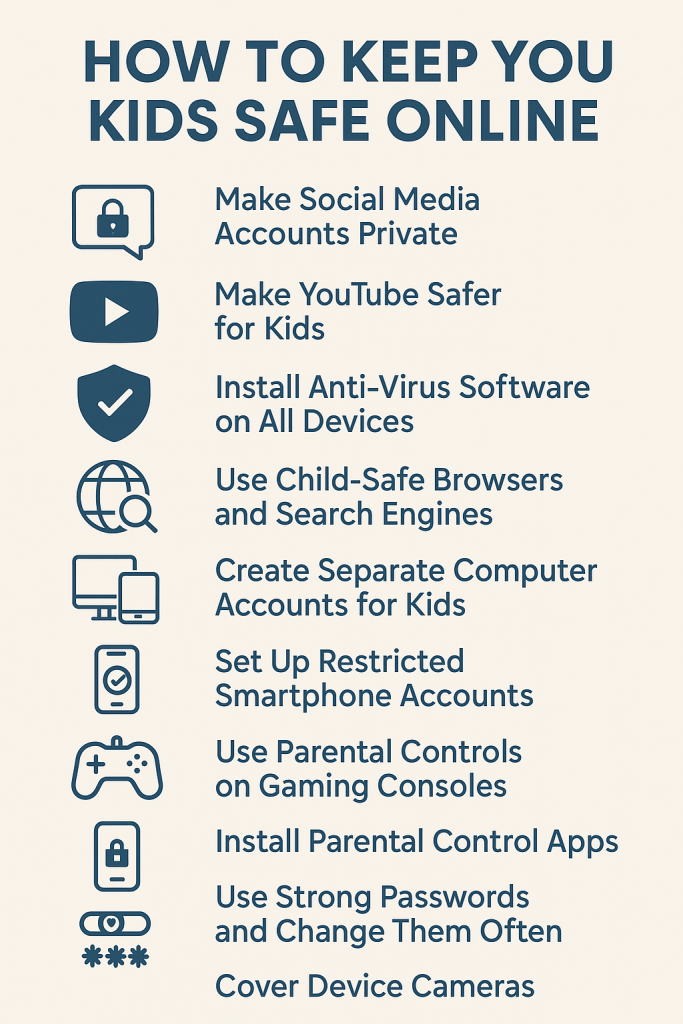
How to Keep Your Kids Safe Online
A practical guide for parents in the digital age
Make Social Media Accounts Private
Social platforms often default to public profiles, which can expose your child to strangers.
-
Children under 13 should not have social media accounts.
-
Set profiles to private on apps like Instagram, Snapchat, and TikTok.
-
Limit who can contact or follow your child.
-
Only accept friend requests from real-life connections.
-
Some privacy setting links:
Note: Even with privacy settings, stories and images can be saved or screenshotted by others.
Make YouTube Safer for Kids
YouTube is popular with kids but not always safe.
-
Use YouTube Kids for children under 13.
-
For older children, turn on Restricted Mode:
-
Go to profile icon > Scroll to bottom > Toggle “Restricted Mode” on
-
-
Set daily time limits using parental controls.
-
Watch content with them when possible.
Install Anti-Virus Software on All Devices
Even kids can download malware accidentally.
-
Use antivirus tools to protect personal data and block harmful websites.
-
Free options:
-
Consider upgrading to a paid version like Kaspersky, which offers full protection.
-
Use a VPN for added security and location masking.
Use Child-Safe Browsers and Search Engines
Standard browsers may expose kids to unsafe content.
-
Install kid-safe browsers like:
-
Zoodles: Free for Mac, Windows, Android. Premium costs $8/month.
-
Maxthon: Free and available on iOS only.
-
-
Activate Google SafeSearch in Chrome to block adult content:
-
Create supervised Chrome profiles:
-
Other child-friendly search engines:
Create Separate Computer Accounts for Kids
Helps manage what children can access and protect adult content.
-
Set up separate user accounts for kids with their own desktop and apps.
-
On Mac, enable parental controls:
-
Manage time limits, website access, and app usage.
Set Up Restricted Smartphone Accounts
Children using phones should have limited access.
-
On Android:
-
Use Google Family Link to:
-
Monitor app use and downloads
-
Block or approve new apps
-
Set screen time
-
Lock the device remotely
-
Track location
-
-
-
On iPhone/iPad:
-
Use Screen Time Restrictions:
-
Settings > General > Restrictions > Enable and set a passcode
-
-
Use Parental Controls on Gaming Consoles
Gaming consoles are connected to the internet and often include chat features.
-
Limit age-inappropriate games and web browsing.
-
Restrict in-game purchases.
-
Learn the safety features of your child’s specific console and enable parental settings.
Install Parental Control Apps
Apps can help manage and monitor screen time, content, and activity.
-
Features to look for:
-
Website and app blocking
-
Location tracking
-
Monitoring messages, photos, and videos
-
Purchase and app approval
-
-
Trusted options include:
Use Strong Passwords and Change Them Often
Protect accounts with strong, hard-to-guess passwords.
-
Use a mix of letters, numbers, and special characters.
-
Avoid using names, birth dates, or common phrases.
-
Example: “Hamburger” becomes H@M8urg3R
-
Change passwords regularly and store them safely.
Cover Device Cameras
Webcams can be hacked.
-
Use a post-it note, slider cover, or webcam blocker.
-
Teach kids never to accept video calls or open links from strangers.
Stay Engaged: Talk and Teach
Talk Regularly About Online Safety
Regular conversations help kids feel safe and supported.
-
Ask what they’re doing online and how they feel about it.
-
Stay updated on online trends.
-
Join communities like the eParenting Group to stay informed.
Use the Same Apps They Use
Being on the same platforms helps you understand the risks.
-
Download the same apps your child uses.
-
Observe the kind of content they engage with.
-
Follow or connect with them on those platforms if appropriate.
Set Family Internet Rules
Clear rules help create safe boundaries.
-
Use a family media contract to set expectations.
-
Include rules like:
-
Screen time limits
-
No phones during meals
-
No downloading apps without permission
-
-
Involve your child in creating the agreement.
Educate About Sexting
Teens may not understand the risks of sharing explicit content.
-
Sexting is illegal for minors and carries lifelong consequences.
-
One in five kids aged 10–15 are involved in sexting.
-
Make it clear that once an image is sent, it can never be taken back.
-
Delay giving a smartphone if you’re not ready for this conversation.
Discuss Cyberbullying and Mental Health
Cyberbullying can severely affect children’s well-being.
-
Explain the harmful impact of online cruelty.
-
Encourage your child to speak up and support others.
-
Talk about suicide and how to help friends who might be struggling.
-
Let them know “joking” about self-harm isn’t acceptable.
Warn About Online Predators
Predators often pretend to be kids and gain trust.
-
Teach your child not to share personal info or images.
-
Show them how online grooming works.
-
Know who your child is connected to online.
Teach About Digital Footprints
Everything online leaves a trace.
-
Help your child understand how their online behavior affects their reputation.
-
Remind them that schools and future employers may check their digital presence.
-
Encourage positive online interactions and thoughtful posting.
Lead by Example
Children model your behavior more than your words.
-
Don’t use your phone during meals or while driving.
-
Be cautious about what you post online.
-
Avoid oversharing personal family details.






